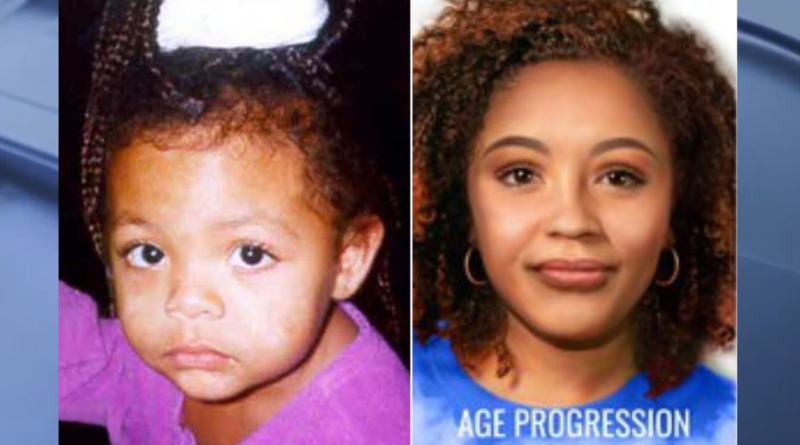Teekah Lewis Forcible Abduction in Tacoma Washington
On a winter Saturday night in Tacoma, Washington, New Frontier Lanes hummed with the usual weekend soundtrack: the heavy roll of balls, the clatter of falling pins, arcade beeps, laughter, and the shuffle of rental shoes on waxed floors. Families mixed with league players; teenagers drifted in clusters toward the glowing machines; parents watched score screens and balanced conversation with quick glances at their kids. Among them was two-year-old Teekah Latres Lewis—tiny, bright-eyed, quick on her feet—darting between the arcade and the seating area while relatives kept her within a familiar, comfortable orbit. In that ordinary swirl of community life, Teekah vanished.
The abduction of Teekah on January 23, 1999, is one of the Pacific Northwest’s most haunting unsolved crimes. It is a case that compresses the fears of any parent into a single brutal possibility: a child can disappear in mere moments, even in a crowded, public place. Decades later, the investigation remains open, the hope still stubborn, and the questions as sharp as the first night they were asked.
The Child Behind the Headline
Before her name became shorthand for a mystery, Teekah was simply a toddler who loved the same things many toddlers love: lights, motion, games, the surprise of a ticket popping from a machine, the pride of showing a parent something new. At two years old, she balanced curiosity with a natural reliance on her family. She had a small child’s agility, weaving through legs toward the hum of the arcade, then boomeranging back within sight. She was not unsupervised; she was living inside the normal messy choreography of a family outing where attention is shared among siblings, relatives, and the little rituals that make a night out feel easy.
The Setting: New Frontier Lanes
Bowling alleys are communities under a roof. New Frontier Lanes offered leagues and open lanes, birthday parties and date nights, cheap thrills and comfort food. The arcade served as the bright nucleus for children who did not yet appreciate bowling’s slower rhythm. Lights chase themselves around bezels, cabinets thump and chime, and the prize counter promises wonders if you can just collect enough tickets.
That architecture matters. An arcade creates sightline problems—corners, cabinets, and people moving in erratic paths. It also creates reasonable confidence; parents can see the glow, hear the noise, and keep watch from a few steps away. In that tension between visibility and obstruction, opportunity can hide.
The Evening and the Vanish
The timeline is both straightforward and chilling. Sometime around 10:20–10:30 p.m., while family members bowled and kept periodic visual contact, Teekah moved in or near the arcade. It took only a sliver of time—seconds, perhaps a minute or two—before she was no longer where she had just been. First comes the ordinary parent logic: she must have stepped behind a machine, or crouched to pick up a token, or wandered five feet the other way. Then the sweep expands—aisle to aisle, lane to lane, restroom door, prize counter—each “not here” turning the temperature down in the stomach and up in the mind.
Within minutes, the search was no longer casual. Staff were alerted, music and games faded into background static, and the bowling alley’s once-relaxing bustle became the sound of the last place she was seen. The parking lot was checked, the doors watched, and a call went out to police.
The Immediate Response
Tacoma officers arrived to a location that remained full of people, cars, and motion—helpful in one way (many potential witnesses) and cruel in another (anyone with knowledge could blend into that same crowd). The building was swept. The restrooms, storage areas, and corners behind cabinets were checked. Outside, the lot, curbs, and the routes leading to nearby streets were examined under bright patrol lights.
Officers collected names and phone numbers, asked for descriptions, and tried to anchor the timeline: When was the last confirmed sighting? Who spoke to her most recently? Where were family members standing in those moments? Which arcade cabinet had she been near? In a busy public place, the first task is to separate the noise of normal human movement from the signal of one act that bends all other motion around it.
Witness Notes and Early Leads
Striking details surfaced in the first wave of statements. Several people recalled a dark, possibly maroon or burgundy, car—often described as a Pontiac Grand Am—moving through the lot at speed around the time the panic began. Inside the alley, a white male in his thirties to forties, shoulder-length or curly brown hair, with a mustache and pockmarked facial skin, had drawn notice for the wrong kind of proximity to children. Neither observation alone establishes a crime; together, they formed the early silhouette of a suspect and a vehicle.
Yet silhouettes can mislead. Memory is elastic under stress, and the same detail—“dark car”—can stretch across a dozen makes and models. The role of investigators is to preserve both possibilities: that these recollections point toward the truth, and that they might be the chaff that the truth hides behind.
A Crime Without a Scene
Abductions from public places rarely leave the kinds of physical anchors that make other crimes solvable: there may be no weapon to test, no obvious transfer of trace evidence, no single bounded “scene” to seal and process. The alley itself is a high-traffic environment where hair, fibers, fingerprints, and skin cells belong to hundreds of innocent visitors. The parking lot trades clarity for asphalt and wind. If a child is lifted and carried—rather than lured over time—seconds determine everything.
In such cases, investigators lean on time and geography: the minute-by-minute map of where the victim and potential witnesses were, who moved which direction, and how quickly a person with a child could reach a waiting car and be gone. Cameras in 1999 were sparse compared to today. Security systems were analog, angles were limited, and retention policies often meant footage was erased quickly. The investigation had to be built on witness testimony, phone tips, and shoe-leather checks of every plausible route away from the building.
The Family’s Marathon
Nothing in life prepares a parent for the sudden, enduring absence of a child. The first hours are survival—answering questions, showing photographs, re-telling the evening’s ordinary moments until exhaustion makes the edges fray. The next days become organization: flyers, press conferences, meetings with detectives, revisiting the site in daylight to translate the panic of night into the map of morning. In the weeks that follow, life splits in two: the visible one where jobs and siblings and bills persist, and the parallel one that runs on interviews, tips, rumors, and renewal of pleas.
Teekah’s family became advocates as well as mourners—keeping her name in public view, marking anniversaries with appeals, and learning the rhythms of cold-case work. They learned how quickly promising tips can collapse, how strangely rumors cross state lines, and how persistence can be both burden and compass.
Community Vigil and Media Attention
Tacoma did not forget. News coverage turned the city’s small pain into a regional one, then a national one, then into an enduring thread that resurfaces whenever a new generation discovers the case. Candlelight vigils kept the story alive in the neighborhood. Law enforcement used anniversaries to refresh descriptions and request information. Age-progressed images—meticulous, hopeful renderings of who a toddler might look like at five, ten, fifteen—kept pace with the calendar, each new image a reminder of both possibility and distance.
Media attention is a paradoxical gift. It creates oxygen for a case and fatigue for those living inside it. The same interview that brings a flood of calls also brings rumor and noise that must be triaged. Still, each feature introduces new eyes and memories to the facts, and sometimes a person who kept quiet in 1999 feels braver in 2009, or 2019, or tomorrow.
The Suspect Profile and Its Limits
The man described at the alley, if connected, represents a specific risk profile: an adult willing to prowl a family space, to target a child, and to exploit the cover that noise, crowds, and routine can provide. If that description is accurate, it narrows possibilities. Yet the distance between a composite and a name can be vast. The question investigators must ask, then and now, is not just “who matches the sketch,” but “who had reason to be there, who left in a rush, who changed patterns, who told a story about that night that fails under weight.”
Potential suspects are weighed against opportunity, proximity, history, and alibi. Vehicles are tracked through registration data, collision repairs, and insurance claims. Mechanics and body shops become secondary witnesses: did someone bring in a dark car with fresh interior changes? Did anyone ask about removing back seats, recovering upholstery, or repainting in the days after the abduction?
Forensic Possibilities, Then and Now
In 1999, DNA work in field investigations was powerful but not ubiquitous, and genealogy-based methods had not yet transformed cold cases. Today, even minute trace evidence can be re-examined with new sensitivity. If any transfer occurred—fibers, skin cells on a tiny garment, material left against a door—the possibility remains that modern labs could do more with it than was possible decades ago. Data tools have also matured: license-plate readers, pattern analysis on historical calls, and digital mapping of old tips against current address histories can expose links once invisible.
Even where no crime-scene DNA exists, genealogy has taught a broader lesson: networks matter. People who commit such crimes are almost always connected—to a home, a job, a hobby, a route, a circle. The case’s endurance means that those connections have had time to loosen. Conscience shifts; relationships end; boasts once ignored can feel scarier in hindsight. Cold-case success often arrives when someone who stayed silent decides that silence is no longer safe.
The Pain of “No Closure”
“Closure” is a word people outside a case use because it sounds gentle. Families inside an unsolved case tend to prefer “answers” and “accountability.” The difference is not semantic. Closure implies an end to grief; answers acknowledge that grief remains but refuses to be nameless. For Teekah’s family, the passing years reorder grief into daily practice: a place at the table that memory still sets, a birthday that is both celebration and petition, a road driven not for nostalgia but for proximity to the last known facts.
The Geography of Opportunity
The area around the bowling alley gave an abductor options. Within minutes, a car can slip from commercial lanes to residential streets; within a few more, onto arteries that erase the micro-geography of a parking lot. Abductors who study such places know this. They park at the edges, face toward exits, and leave no more trail than a tail light turning a corner. Investigators reconstruct those options in reverse, running time-and-distance problems: from the last confirmed sighting to a moving car to the nearest intersection to the likely on-ramp. That math remains useful even decades later when paired with address histories of persons of interest and known offenders with similar methods.
False Leads and “Almost” Moments
Every long case accumulates near-misses: tips that almost align, names that almost fit, vehicles that almost match. The public meets those near-misses only when they rise high enough to require comment; families encounter them constantly. Each one costs hope and time. The discipline of a good investigation—then and now—is to test every “almost” without letting it rewrite the known facts. The last confirmed moments cannot be bargained with; they are the fixed points against which all stories must be measured.
What Endures: A Call, a Face, a City’s Promise
Despite the years, certain images remain stubborn: a two-year-old’s face in photographs; an arcade’s blue-green glow; a family standing near the doors waiting for police lights; a composite sketch; a dark car turning out of a lot; a mother’s voice repeating details she should never have had to memorize. These are not just artifacts of a crime; they are anchors for a promise—Tacoma’s promise to keep looking, to keep asking, to keep treating an old case as today’s work.
That promise has practical shape. It is the re-circulation of age-progressed images. It is the careful preservation and re-examination of stored evidence. It is the continued invitation to those who were present that night—employees, league members, families, teenagers who are now middle-aged—to sift their memories once more, this time with the patience of hindsight and the courage to speak if something, however small, surfaces.
How Cases Like This Break
In the modern era, child abduction cases break open in a few repeatable ways: a person confesses to a confidant who finally reports it; a genealogical or forensic advance squeezes a long-dormant trace into a name; a vehicle or object once hidden resurfaces and points backward; or a witness who minimized or misremembered a detail comes forward with specificity that triangulates an identity. Each pathway depends on the public treating the case as current—not as a sad story from the past, but as an incomplete problem that still needs a witness.
Specificity is the key. Vague impressions rarely move a case; concrete memories can. A partial license plate paired with a distinctive bumper sticker. A name and a workplace for a man who matched the description and abruptly moved. A recollection that someone replaced an interior panel or sold a dark car quickly after that weekend. Investigators can test specifics; they can only endure generalities.
A Mother’s Message and a Community’s Role
Behind the reports and timelines is a mother’s steady message: my child deserves to be found, and the person who took her must be named. Communities answer that message by refusing to let the case drift into folklore. The difference is subtle but crucial. Folklore turns a crime into a cautionary tale and then into a ghost story; a living case keeps names, addresses, maps, and dates at the center. It asks not for fear, but for attention.
The Work Still to Do
The work is clear even now. Re-interview those who were present with the advantages of today’s techniques. Re-test any preserved material. Re-map vehicles registered in relevant years against employment and residence histories near the bowling alley. Re-publish age-progressed images to audiences who did not exist when the case first aired. Re-ask the community to select memory over myth and detail over dread.
And above all, re-center the person at the heart of the story: a little girl who should have gone home sleepy in a car seat with the smell of bowling oil in her hair and sticky arcade fingers, whose family should be telling embarrassing toddler tales to a grown woman by now. Justice, in a case like this, starts with refusing to speak of the child only as a symbol. It ends, if we are fortunate, with a name, a charge, and the hard clean facts that make courts work and families breathe again.
Discover more from City Towner
Subscribe to get the latest posts sent to your email.




